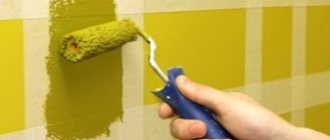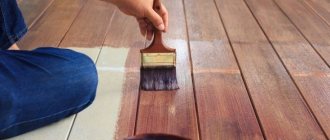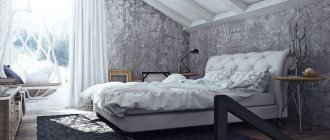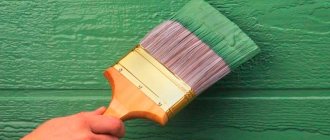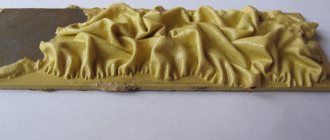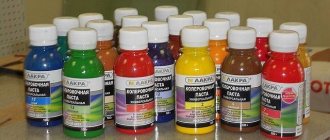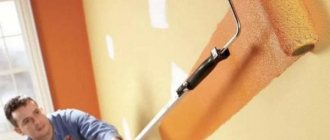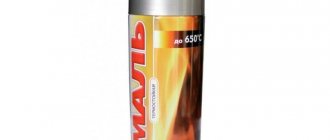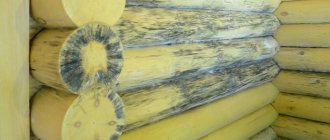Natural-based building materials remain the most popular, and many are interested in whether it is possible to paint wood with water-based paint. Painting a surface with a wood texture has its own secrets, thanks to which it is possible to preserve the specific texture of the wood. Water-based compositions can be used for painting wood due to their special consistency.
Features of water-based paint
Water-based paint is a repair material filled with coloring pigments and binding components that provide reliable adhesion to the surface being treated. The basis of the composition is water. Pigments are not dissolved in the paint, but are present in it in the form of a suspension. After applying the suspension to the product, the water molecules evaporate, and the pigment component is transformed into a thin layer resembling a film.
This paint may also contain additional components:
- powerful antiseptics that prevent the spread of fungus and mold;
- antifreezes that prevent emulsion freezing;
- thickeners that provide optimal paint consistency;
- defoamers that prevent excessive foam formation.
When fruit trees are whitened, what composition is best to use for whitewashing?
Tree trunks covered with white composition give the garden as a whole a special and festive look. But it is clear to everyone that gardeners periodically renew the whiteness of their trunks not at all in order to give them a special design. First of all, the treatment of trunks in spring and autumn is carried out solely in order to protect them from the harmful effects of ultraviolet rays.
Classification of materials
Water-based paints are offered by manufacturers in two main versions: facade and for interior work.
There are several types of water-based paint:
- Acrylic. It has high strength and elasticity parameters. The main binding component is acrylic resin.
- Silicate. Which contains not only water and pigments, but also a solution of liquid glass. It is highly resistant to weather conditions, and therefore is actively used for external work.
- Silicone. Made from silicone resin and water.
- Mineral emulsion paint. Which contains cement or slaked lime. Today it is practically not used in construction.
Paint for exterior woodwork has a number of differences from the composition intended for interior finishing. It is more resistant to moisture and temperature changes, as well as to dirt and ultraviolet radiation.
What surfaces can be painted with water-based emulsion?
Water-based compositions for wooden surfaces are produced on the basis of PVA and latex. Both compositions are made from natural raw materials. Depending on the content of a particular component that is chosen as the basis of the material, we can talk about the scope of application and the result obtained.
PVC-based paints and white glue go well with wooden surfaces. The composition dries in just a few hours, after which a thin film coating is formed on the wood, the floor is matte, the structure is porous.
Paint based on butane-diene-styrene polymer compounds is easy to use. Available in the form of a paste, diluted before use. There is no smell, the surface is smooth and pleasant to the touch. Most often used to create interior interiors.
Water emulsion for wood
Paintwork materials can be used not only for interior and exterior decoration, but also to protect trees. Painting trees with water-based paint helps protect the wood from cracking under the influence of high humidity and destruction from temperature changes.
For these purposes, alkyd, alkyd-oil or simply oil compositions are often used. It is important that the bark breathes. Therefore, PVC-based paints and varnishes are most often used to seal branch cuts and protect them from pests.
A separate question is whether it is possible to paint fruit trees with water-based paint. Most often they are treated with lime, which should be renewed every year, since the composition is quickly washed off. Sometimes you even have to paint it twice a year.
Currently, manufacturers have developed a special composition - special latex paint, which lasts longer. But whether it is worth using water-based emulsion is still being debated. The fact is that the film formed on the surface does not allow the bark to breathe, and many experts consider this harmful to the growth, development and fruiting of the tree.
Experience shows that the use of water-based compositions does not cause harm, but more often lime is still used for these purposes. Whether to paint the tree with water-based paint or prefer another treatment is up to the garden owners to decide on their own.
Lining finishing
The lining has an interesting wood structure in appearance, and often does not need painting. But in certain cases it is better to cover it with paint and varnish. Water-based paints give the surface a pleasant matte tint, but do not hide the grain of the wood. The advantages of using this composition include the fact that it is not inferior in protection to varnishes.
It is preferable to paint the lining with water-based paint when thin boards are used for interior and exterior decoration of the house. Paintwork materials are also used in situations where the lining has lost its visual appeal. Water-based paint will preserve an interesting texture and will not hide knots or wood fibers.
Affordable price, cleanliness, moisture resistance, fire safety and other positive qualities are the main advantages that make water-based paint an attractive option for finishing wooden surfaces.
Advantages and disadvantages
Water-based materials have a number of advantages compared to water-dispersed compositions:
- The film formed on the surface does not prevent air penetration.
- The solvent for this paint is water, and therefore the painted surfaces are non-toxic.
- A varied color palette significantly expands the possibilities of selecting the shades needed in a particular design.
- Simple tools can be used to apply the coating.
- The peculiarities of the composition allow the use of household chemicals on painted surfaces when cleaning, so that even stubborn stains can be easily removed.
- Removing it from the skin is also not difficult - just wash your hands with soap.
- The elasticity of the material prevents the formation of cracks.
- They have a long service life.
However, it is necessary to take into account the disadvantages that the emulsion has. Compared to water-dispersed options, it is more vulnerable to moisture. The water content in the composition can lead to swelling of the wood, so there is a need for additional processing of the wooden coating. This material does not fit well on a glossy surface.
Scope of application
This material can be used for painting interior surfaces: walls, ceilings, doors, frames, lining, various wood panels and so on. It can be used for finishing residential, commercial and public premises. Due to their efficiency and fire safety, acrylic paints are often used for decoration of hospitals, educational institutions and public catering establishments.
Acrylic compositions for wood are absolutely safe and can be used in any room, both for painting walls and for working with ceilings and furniture
Carrying out painting work
When you ask the question whether it is possible to paint untreated wood with water-based paint, first of all, determine for yourself what result you want to get? If you need a neat surface with a durable protective layer, then it is probably better to do some surface treatment.
How to prepare a wooden surface:
- First you need to thoroughly clean the wood using a soft sponge, brush and detergent.
- The boards need to be degreased. If they have darkened, they can be lightened using “Whiteness” or special means.
- The surface needs to be sanded. For this purpose, pumice stone, sandpaper or a grinding machine with various attachments are suitable.
- If necessary, the resulting cracks can be filled with putty (water-based paint for exterior work will adhere much better). It needs to be allowed to dry and then sanded.
- After sanding and filling, wooden surfaces must again be cleaned of dust.
- A flat surface should be treated with a colorless antiseptic against fungus and mold. Such preventive measures are especially important for façade cladding.
- Let the wood dry thoroughly.
Color palette
The choice of color to paint the surface is an important point. After all, a well-chosen color can easily transform objects, and if we are talking about painting the walls in a room, it will create a special atmosphere.
The color range includes not only colored shades, there are also transparent types that highlight the natural grain of the wood. Belaya kraska and other light colors reflect warmth, which is useful in warm regions. White and light-colored coatings heat up less than dark ones and are therefore more durable.
The production process allows products to be tinted using computer programs; they determine how much pigment needs to be added and what colors to mix to get the desired tone.
White and light-colored coatings heat up less than dark ones and are therefore more durable.
Methods of applying paint to wood
To perform finishing work with water-based materials, you can use a spray gun, roller or brush.
The spray gun is preferred in cases where large areas need to be treated. Pros of this tool:
- The coating is smooth;
- The time required for wall treatment is minimal;
- It is possible to paint even the most complex surface areas without using a brush;
- The material is consumed in less volume (compared to the manual method).
Using a paint roller creates a slightly thicker layer, so you may need fewer coats of paint to achieve the desired effect.
The disadvantages of this method of wood processing include: relatively low productivity (compared to the previous tool), energy consumption, and the difficulty of painting hard-to-reach areas.
The process of painting with a brush is quite labor-intensive, and the consumption of material is much higher, since the paint does not apply evenly on wood. Therefore, when painting large areas, it is recommended to use a brush in combination with a roller.
How to paint trees
Whitewashing is carried out in dry weather so that rain or snow does not wash away the fresh paint. In mature trees, the trunk (the lower part of the trunk) and the thick (skeletal) branches adjacent to it are whitened. These parts of the plant are the most vulnerable: they cannot recover when damaged, as roots or young shoots do.
Seedlings and young plants 1-2 years old are not painted to avoid damage to the thin, delicate bark. If necessary, resort to other measures to protect against frost, burns and rodents: tying with spruce branches or covering material, installing fine mesh.
Preparing trunks for processing
The trunk of apple, plum, pear and other fruit trees needs to be cleaned and disinfected before autumn painting.
This procedure is performed to prevent fungal infections of wood and to better fix the coloring composition on the bark.
Preparatory work is carried out in several stages:
- Burlap or a piece of thick fabric is spread under the crown.
- Using a plastic or wooden scraper, clean the trunk of mosses, lichens, and dry fragments of bark.
- A disinfectant solution prepared from copper sulfate, stove ash, green soap, or a ready-made industrial composition is applied to the cleaned surface.
- Large cracks, damage, and hollows are cleaned and sealed with garden varnish.
- If necessary, remove dry branches and trim the crown.
To prevent the spread of pathogenic microorganisms throughout the garden, the protective fabric is burned along with the garbage. It is better to do this outside the site.
Methods of applying paint to wood
It is more convenient to apply paint from top to bottom: this avoids smudges. The layer should not exceed 2 mm in thickness so that the wood can “breathe”.
The trunks are whitened with the following tools:
- Paint brush. For work, choose a wide, flat brush with artificial bristles. Adult plants can be painted with poppy seed, as it allows you to immediately cover a large area of bark.
- Spray gun. This method is suitable for those who have many fruit trees growing in their garden. The spray gun economically consumes paint and varnish material, applying it in an even thin layer.
- Paint roller. With this tool, paint is applied quickly, easily and evenly. However, it is not able to cover hard-to-reach areas as well as a brush. Therefore, whitewashing with a roller is recommended for smooth trunks without visible damage.
Whitewashing is carried out in October-November after the end of the period of autumn showers and the air temperature drops to -2...-3°C.
